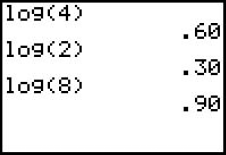18.3. Properties of Logarithms
18.3.1. Products
We will soon be solving exponential and logarithmic equations. For them we need to know some properties of logarithms. For example, how do we find the logarithm of the product of two numbers?

T1-83/84 screen for the exploration. You may have observed in the exploration that log 8 is the sum of log 4 and log 2. The calculator is set to show two decimal places.
▪ Exploration:
Try this. Find by calculator, using common logs:
| log 4 | log 2 | log 8 |
Can you find any relationship between the three numbers you have found?
Can you express this relationship, if it turns out to be true, as a general rule?
Repeat, using natural logs. Does the same relationship seem to hold?
We wish to write an expression for the log of the product of two positive numbers, say, M and N.
- logb MN = ?
Let us substitute: M = bc and N = bd where b > 0 and b ≠ 1. Then
- MN = bcbd = bc+d
by the laws of exponents. Writing this expression in logarithmic form, we have
- logb MN = c + d
But, since bc = M, c = logb M. Similarly, d = logb N. Substituting, we have the following equation:
NOTE
![]()
The log of a product equals the sum of the logs of the factors.
Example 29:Here are examples showing the log of a product.
|
NOTE
The log of ...
Get Technical Mathematics, Sixth Edition now with the O’Reilly learning platform.
O’Reilly members experience books, live events, courses curated by job role, and more from O’Reilly and nearly 200 top publishers.

